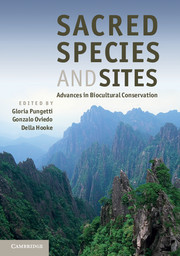Book contents
- Frontmatter
- Contents
- List of Contributors
- Foreword
- Preface
- Acknowledgements
- Introduction
- Part I Concepts and Knowledge
- Part II Sacred Landscapes
- Part III Sacred Sites and People
- Part IV Sacred Species
- Part V Sacred Animals
- 17 Genealogy of the sacred: Maori beliefs concerning lizards
- 18 Pheasant conservation, sacred groves and local culture in Sichuan, China
- 19 The bear cult among the different ethnic groups of Russia (sacred Russian bear)
- 20 Specific-species taboos and biodiversity conservation in Northern Madagascar
- Part VI Sacred Groves and Plants
- Part VII Implementation and Conclusions
- Index
- Plate Section
- References
17 - Genealogy of the sacred: Maori beliefs concerning lizards
from Part V - Sacred Animals
Published online by Cambridge University Press: 05 August 2012
- Frontmatter
- Contents
- List of Contributors
- Foreword
- Preface
- Acknowledgements
- Introduction
- Part I Concepts and Knowledge
- Part II Sacred Landscapes
- Part III Sacred Sites and People
- Part IV Sacred Species
- Part V Sacred Animals
- 17 Genealogy of the sacred: Maori beliefs concerning lizards
- 18 Pheasant conservation, sacred groves and local culture in Sichuan, China
- 19 The bear cult among the different ethnic groups of Russia (sacred Russian bear)
- 20 Specific-species taboos and biodiversity conservation in Northern Madagascar
- Part VI Sacred Groves and Plants
- Part VII Implementation and Conclusions
- Index
- Plate Section
- References
Summary
Introduction
In a paper on the cultural context of resource management, Nakashima (1998) challenged scientists to accept the validity of other representations of ‘reality’ and acknowledge that these may offer more appropriate and sustainable ways of managing our environment. Indigenous knowledge developed over long periods of time and involving close intimacy between peoples and place contains insights and understandings that are needed today if we wish to manage and protect species and sites in ways that include rather than exclude people. Fundamental to all knowledge is the identification, naming and categorisation of all things in a particular place.
Either by uniquely creating order out of apparent disorder or, alternatively, by perceiving the order already inherent in nature (Berlin, 1992, pp. 8–13), different societies create frameworks grounded in their own metaphysical paradigm upon which to situate all known things. Among indigenous societies these frameworks reveal not only the perceived order and relationships of all things to each other and to their origins, but also the moral and spiritual ‘cosmoscape’ within which the place of humans is defined and their actions governed and regulated (Reichel, 2005).
At a more practical level, these mental maps can function as a ‘folk taxonomy’ or ethno-classification which provides insights into those natural resources and other phenomena of importance to the physical and spiritual survival of a particular culture.
- Type
- Chapter
- Information
- Sacred Species and SitesAdvances in Biocultural Conservation, pp. 249 - 264Publisher: Cambridge University PressPrint publication year: 2012



